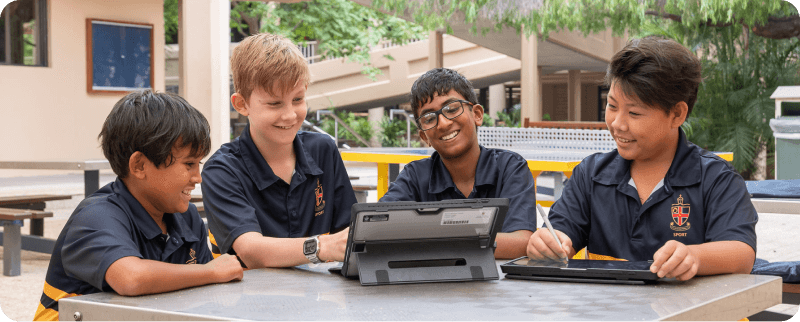For many educators, the rapid rise of artificial intelligence (AI) can feel daunting. With countless tools and a new set of challenges around academic integrity and data security, it’s easy to feel overwhelmed.
But what if we saw AI not as a threat, but as a partner to make teaching more effective and fulfilling?
Shane Smith, co-founder and head of AI innovation at Education Perfect (EP) recently explored this question with Matt Titmanis, a seasoned science head of department. Their insights reveal that AI is not coming to replace teachers: it’s here to empower them.
The Biggest Win: Personalised Learning
The most significant benefit of AI lies in its ability to deliver true personalisation at scale. Teachers have always strived to differentiate instruction for every student, but the sheer time commitment makes this nearly impossible. AI changes that.
For example, AI can:
- Differentiate content instantly: A teacher can use AI to adapt a complex text to a simpler reading level, or generate an alternative lesson plan that covers the same topic for students with diverse learning needs.
- Automate formative feedback: AI can provide immediate, targeted feedback, guiding students toward a better answer in real time. This not only saves teachers countless hours, but creates a “learning loop” where students are encouraged to re-engage with the content and improve. A recent study showed that with this automated feedback loop, the quality of student responses improved by nearly 50%.
- Streamline admin tasks: From generating quiz questions and designing assessments to creating mastery checks, AI handles the repetitive work that often keeps teachers working after hours.
Navigating the Practical Challenges
While the benefits are clear, schools must approach AI with a practical and pragmatic mindset. The primary challenges of AI revolve around compliance and academic integrity.
- Policy and approved tools: To protect student data, education departments enforce strict rules on software and security standards. As a result, many popular AI chatbots aren’t accessible in schools. The safest option is to use AI built into approved platforms, or tools that have standardised security credentials, such as Safer Technologies for Schools. This guarantees data is secure and compliant with regulations.
- Academic integrity: With AI tools widely available, we must assume that students will use them, especially for take-home work. The solution isn’t to ban AI, but to rethink assessment. The focus should shift from simple knowledge recall to critical thinking and application. AI can assist teachers to design assessments that require in-class validation or tasks that demonstrate ability to analyse and synthesise information.
The Teacher’s Evolving Role
This new landscape presents a profound opportunity for teachers to redefine their classroom role.
- Augmentation, not replacement: The question isn’t “Will a robot replace me?” but “How can AI augment my teaching?”. By taking over repetitive tasks, AI frees teachers to focus on the human-centered work that can’t be automated: building relationships and inspiring curiosity.
- A growth in skills: Teachers can become facilitators of learning, skilled in selecting the right AI tool for certain jobs. Just as importantly, they model for students how to use AI responsibly and evaluate information with a critical eye.
- Fostering essential skills: As AI handles routine tasks, the most valuable skills for students are critical thinking, analysis and ethical reasoning. Our role as educators is to teach students how to question, critique and build upon AI’s output, so they don’t simply accept everything it says as fact.
Getting Started: A Simple First Step
For any teacher feeling overwhelmed, the best advice is to start small. Don’t feel pressured to master every tool.
- Start with a quick win: Choose one small, repetitive task and ask an AI tool to help. Ask it to generate a few short-answer questions for your next quiz, or draft a simple lesson plan on a topic you’re teaching.
- Experiment: Don’t be afraid to try different tools. Different AI models excel at different tasks, and what didn’t work a month ago might work perfectly now.
- Collaborate: AI is a journey of exploration, and you don’t have to go it alone. Share what you learn with your colleagues and build a community of practice.
Rather than replacing teachers, AI is here to amplify their impact. AI helps clear space for the deeper work of teaching: nurturing curiosity, building confidence and shaping lifelong learners.
An AI Tool for Your Classroom Needs
Developed by teachers, for teachers, Education Perfect (EP) is a complete digital learning, assessment and analytics toolkit that empowers teachers to personalise learning at scale and meet evolving classroom needs. With this in mind, EP’s AI-Powered Feedback Tool is designed to be safe and impactful, it provides a meaningful learning experience that prioritises quality and drives results.
Want to see how EP’s AI tool can be a part of your unique classroom solution? Request a free trial today!
]]>AI is no longer a distant promise; it’s actively reshaping how students learn and how teachers teach. In Teaching with AI: A Practical Guide to a New Era of Human Learning (Bowen & Watson, 2024), the authors argue that AI-powered tools such as adaptive learning platforms, intelligent tutoring systems, and automated feedback mechanisms, are already enhancing educational practices. Similarly, Creative Applications of Artificial Intelligence in Education (Springer, by leading AI‑in‑education researchers) provides case studies across K–12 and higher education showing that generative AI (GenAI) is actively being implemented to tailor learning pathways, enrich lessons with interactive simulations, and support formative feedback in real time.
With the release of the Australian Framework for Generative AI in Schools, teachers are now being equipped with clear guidelines to use AI tools responsibly and effectively.
Where AI Is Transforming the Science Classroom
Artificial intelligence (AI) is actively transforming educational paradigms, profoundly influencing both student learning and pedagogical practices. Emerging approaches in science education include:
- Personalised learning pathways – AI tailors content to match each student’s level, pace and style, empowering you to keep learners engaged and progressing confidently.
- Targeted feedback and insights – automated feedback and predictive insights give teachers a clearer picture of where students are at and what support they need, allowing for more targeted and meaningful interventions.
- Virtual labs and data tools – AI enables practical experiences like simulations and data analysis, strengthening research skills, even without physical lab access.
- Interactive learning experiences – AI-powered modules and games make science concepts more engaging and easier to understand.
- AI tutors – provide additional, tailored support for students who need reinforcement or clarification.
- Cross-curricular learning – Gen AI helps students connect science with other subjects, encouraging them to think creatively and make broader real-world connections, for example a Year 8 teacher uses Gen AI to help students explore how tectonic activity shapes not just landscapes but also history and culture, blending science with social studies in a single, creative inquiry.
Together, these innovations create a more accessible, dynamic, and personalised science learning experience.
Aligning AI with the EP Learning Cycle
AI fits naturally into the EP Learning Cycle, enhancing each phase to make your teaching more targeted and learning more effective.
During Actionable Assessment, EP’s AI-powered diagnostics establish a clear baseline for each student, surfacing learning gaps and identifying readiness for new content. As EP’s Australian Curriculum Specialist and experienced science teacher Kelly Hollis noted in a recent webinar, this kind of diagnostic insight “takes the guesswork out of planning,” allowing teachers to be more intentional and responsive in their next steps.
In the Individualised Instruction phase, EP draws on performance data to suggest curriculum-aligned resources and provide tailored support for students needing more time with key science concepts. This ensures that in Kelly’s words “every student gets what they need, when they need it”, a principle that underpins EP’s adaptive platform.
Finally, in Purposeful Practice, EP leverages AI to recommend revision tools aligned to student needs and provides immediate, constructive feedback on extended response questions. This helps students develop critical thinking and problem-solving skills in science, while teachers gain rich insights into student progress. AI doesn’t replace the teacher, it enhances their ability to teach with precision, confidence, and care.
Supporting Teachers, Not Replacing Them
At EP, AI is designed to sit beside the teacher, not in front of them. AI’s role is to enhance teaching by offering timely insights, personalised feedback, and adaptive support, all within existing classroom workflows.
By handling repetitive tasks and surfacing patterns in student understanding, AI frees up teachers to focus on the deeper work of science pedagogy: guiding inquiry, clarifying complex ideas, and supporting critical thinking.
While AI can identify misconceptions and recommend next steps, it’s the teacher who interprets that information and makes the instructional calls. In science especially, where curiosity, dialogue, and experimentation are key, human judgment remains at the heart of great teaching.
Keeping AI Safe, Fair and Focused on Learning
As AI tools become more widely used by students, there’s a growing need to distinguish between support and substitution. Rather than students turning to AI to generate answers outright, EP’s AI-powered feedback tool is intentionally designed to guide, not do the work for them. It provides individualised prompts that encourage students to reflect, revise, and improve their responses, fostering a growth mindset and deeper engagement with the learning process.
This approach aligns with the Australian Government’s principles for safe and ethical AI in schools, which stress that AI should enhance human learning rather than replace it.
EP also upholds critical standards for data privacy, hosting sensitive student data securely and ensuring transparency in how insights are generated.
Aligned with the broader goals of equity in Australian education, EP ’s on-device, curriculum-aligned feedback doesn’t rely on high-end hardware or extra downloads. It scaffolds student improvement within their usual lessons, helping to ensure AI doesn’t become a privilege, but a reliable educational partner for every student.
Looking Ahead
AI is becoming a powerful partner in the science classroom, and with EP, it’s already helping teachers to personalise learning, streamline assessment, and keep students engaged in ways that were hard to imagine just a few years ago. By bringing clarity to student progress, AI allows you to focus on what matters most: inspiring curiosity, deepening understanding, and helping every student move forward. As Education Perfect continues to innovate with AI, the potential for groundbreaking advancements in teacher impact remains a significant and thrilling frontier.
Learn more about how AI is transforming science classrooms with our science subject specialists.
]]>The numbers bear this out. The federal government in Australia has projected a shortfall of over 4,000 high school teachers by 2025 [1]. Across the Tasman, the New Zealand Ministry of Education has also projected a shortage, with an estimated 500 secondary teachers needed in 2025 [2].
This isn’t just about empty classrooms; it’s about the innovative and often difficult solutions schools are forced to adopt. At the forefront of these challenges is the growing prevalence of “out-of-field” teaching, where a teacher is asked to step in and lead a class in a subject they are not trained to teach.
While this demonstrates the incredible adaptability of our teachers, it’s not a sustainable or ideal solution. For example, the current shortage of language specialists is particularly acute, with one Queensland survey revealing that 44% of schools reported a shortage of language teachers [3]. In New Zealand, a recent survey found that a staggering 56% of principals have teachers working in non-specialist areas, the highest figure on record [4]. This means a qualified English or humanities teacher might suddenly find themselves trying to deliver a French, Japanese, or te reo Māori curriculum.
The pressure to master a new subject, develop resources, and keep students engaged is an immense burden on an already overstretched professional. The issue is widespread, with recent Australian research citing data from the Australian Institute for Teaching and School Leadership (AITSL) indicating that up to 40% of mathematics teachers and 36% of humanities teachers are teaching out-of-field [5].
It’s time that the conversation moves beyond simply identifying the problem to exploring practical tools that can support our educators. The reality of out-of-field teaching calls for creative solutions that lighten the load on staff. This includes access to high-quality, pre-built resources, technology that automates repetitive tasks, and digital platforms that enable more effective independent learning.
Solutions for Stretched Teachers and Schools
In this challenging environment, a resource designed to help teachers is a powerful support system. By building confidence for those teaching out-of-field, technology enables a teacher to walk into a new classroom prepared. A rich, structured library of curriculum-aligned content means your staff no longer have to build a new subject from the ground up. They can focus on what they do best: connecting with their students and guiding them through the content.
Using AI to Support Independent Learning
Another powerful way that technology is helping is by leveraging artificial intelligence to support independent learning. By giving students instant, personalised feedback on their work, these tools empower learners to progress at their own pace, revise effectively, and access expert guidance anytime, anywhere—even when a specialist teacher isn’t available. This shift not only builds student autonomy but also serves as a crucial support system for the teacher in the room.
The AI-Powered Feedback Loop
Education Perfect’s AI-powered feedback loop dramatically reduces the marking load. As students complete tasks, it provides immediate, personalised feedback. When a student submits an answer,the loop doesn’t just mark it as right or wrong. Instead, it instantly analyses their response to identify the specific error. It then provides targeted feedback, which can include a detailed explanation of the concept, a subtle hint to guide them toward the correct solution, or even a link to a relevant lesson or video for a quick review. This immediate and constructive feedback helps the student understand why their answer was incorrect and gives them the tools to try again. The loop continues, with the AI providing progressive support, until the student demonstrates a solid grasp of the topic.

The current challenges are making it more difficult for teachers, heads of department, and education leaders to ensure teaching is effective and empathetic. By choosing tools that address the challenges, educators can ensure that every student continues to receive a quality education while also helping to build a more sustainable and supportive environment.
You can see how AI tools can lighten the load for teachers and support staff. Sign up for a free trial of Education Perfect now, and you will see how the problems that teachers face in out-of-field teaching can be substantially reduced.
References
[1] Australian Government Department of Education, Teacher Supply and Demand Report, 2022.
[2] New Zealand Ministry of Education, Teacher Demand and Supply Planning Projection, 2024.
[3] Queensland Teachers’ Union (QTU), Staffing Shortages Survey, 2023.
[4] Post Primary Teachers’ Association (PPTA), Secondary School Staffing Survey report, 2024.
[5] Deakin University, Out-of-Field Teaching Across Teaching Disciplines and Contexts, 2022.
]]>Why Competitions Work
Competitions tap into students’ natural drive to succeed, turning learning into an experience rather than an obligation. They create an environment where students are not just working towards grades but actively participating in a journey of discovery and growth.
Lana Svonavec, HOD at Science Tintern Grammar School and one of the educators featured in the webinar, emphasised the impact of competitions:
“Competitions offer students a fun, dynamic way to engage with content. It’s not just about winning – it’s about seeing how far they can push themselves and discovering their own potential.”
When students see measurable progress in a competitive setting, it reinforces their confidence and willingness to engage more deeply with the subject matter.
Encouraging Motivation and Resilience
A key benefit of competitions is their ability to motivate students to take ownership of their learning. When students are given a challenge, whether an individual or team-based competition, they often rise to the occasion, setting personal goals and striving to improve.
Kiraly Payne, a Language Executive Teacher at Amaroo School, ACT, highlighted how competition enhances perseverance: “When students feel seen and supported, they’re more willing to take risks, make mistakes, and engage fully in the learning process.”
This growth mindset not only helps students academically but also builds resilience, teaching them to embrace challenges as opportunities rather than obstacles.
The Role of Digital Platforms in Competitions
Technology has revolutionised the way academic competitions are run, making them more accessible, engaging, and rewarding. With platforms like EP, students can participate in global challenges that give them a sense of connection beyond their classroom walls.
Lana Svonavec shared her experience with EP competitions: “Competitions like the EP Languages Championship and the EP Science Championship allow students to see tangible rewards for their efforts, helping them feel accomplished and motivated to keep learning.”
These competitions provide instant feedback, interactive content, and leaderboards, making the experience immersive and rewarding.
Building a Collaborative Learning Culture
While competition is often associated with individual achievement, it can also foster collaboration and teamwork. Many EP competitions encourage students to work together towards common goals, creating a shared sense of purpose and camaraderie.
Through collaboration, students develop communication skills, critical thinking and peer learning, all essential skills for future success. Whether in language challenges, maths quizzes, or science problem-solving tasks, competitions offer an engaging way to reinforce teamwork and shared learning.
A Tool for Every Student
Perhaps one of the most significant advantages of academic competitions is their inclusivity. They cater to a wide range of learners – whether high achievers looking for a challenge or students who may need a new way to engage with content.
Kiraly Payne summed it up perfectly: “Students aren’t just sitting back and absorbing information—they’re interacting with it. They’re testing themselves, learning through doing, and staying much more engaged.”
Competitions provide multiple entry points for engagement, ensuring that all students, regardless of their starting point, can find success and enjoyment in learning.
Unlocking Potential Through Competition
The insights shared by these educators reinforce a fundamental truth: competition, when structured thoughtfully, is a powerful catalyst for student engagement and learning. It brings energy into the classroom, drives students to challenge themselves, and fosters a culture of perseverance and collaboration.
By incorporating competitions into the learning experience – whether through digital platforms, classroom challenges, or global events – educators can inspire students to embrace learning with enthusiasm and confidence. As students push their boundaries and celebrate their progress, they develop not just knowledge but a lifelong passion for discovery.
Want to bring the power of competitions into your classroom?
Take part in our EP World Series Competitions, free for all students with an EP account across Australia, New Zealand and select International Schools.
Want to add a splash of colour to your classroom walls? Download our free Languages Championships posters here!
]]>As AI becomes more prevalent in education, 2025 presents an opportunity to define it as the “Year of Efficacy in AI and EdTech.”
In Education Perfect’s (EP) recent Independent and Catholic School Roundtable discussions on assessing the impact of AI tools in secondary education, school leaders shared where they’re at in their AI journey: what’s working, what’s worrying, and what’s next for them.
Here are the key takeaways from the discussion:
1. AI Implementation & School Policies
The journey to AI adoption in schools is varied, with many institutions still in the early stages of exploration. A major theme that emerged was the need for clear AI policies and frameworks, as the speed of implementation is often dictated by system policies, and many are waiting on clearer guidelines.
One message rang loud: a thoughtful, school-wide AI framework is crucial for any school. It allows educators to confidently engage with AI tools while ensuring that privacy, security and ethical considerations are prioritised. As AI tools become more integrated into classrooms, schools are looking for ways to balance innovation with compliance, ensuring that AI usage aligns with all educational objectives.
2. Data Security & AI Tool Evaluation
As schools are increasingly selective about the AI solutions they adopt, IT teams are conducting rigorous quality checks to ensure tools meet privacy and safety standards. These evaluations are not only guided by system policies but also by a deep commitment to safeguarding staff and student data.
Schools are aware of the risks AI tools may present to data privacy, and many are still in the process of assessing which tools can be trusted. Before fully integrating AI into their systems, educators and administrators require concrete data on how AI will impact learning outcomes. At EP, we take these standards seriously, ensuring our AI tools meet the highest data security expectations.
3. AI in Teaching & Learning
One of the most promising uses of AI in education is its ability to alleviate the administrative burden on teachers. AI tools are being used to streamline lesson planning, report writing and feedback generation, allowing educators to spend more time engaging with students. Additionally, AI provides instant formative feedback on student tasks, enabling timely interventions and learning adjustments.
AI is also being explored for personalised learning, with some tools leveraging AI-driven learner profiles to customise assignments based on student capabilities. This approach has proven beneficial for students with lower literacy levels, as AI can adapt content to match their needs, making learning more accessible.
4. AI & Academic Integrity
As AI tools become more integrated into classrooms, concerns about academic integrity are growing. False positives from AI-detection tools, and the risk of over-reliance on AI for assignments, have schools looking for balance. Teachers are responding by embedding transparency, encouraging critical thinking, and developing students’ ability to evaluate AI-generated content.
Studies suggest that students performing at a mid-range academic level may benefit the most from AI interventions, while high-achieving students may see a plateau. More research is needed to assess the long-term effects of AI on students at all academic levels.
5. The Quest for Evidence: A Desert of Data
While AI’s administrative benefits are clear, schools are still asking: Is it actually improving learning outcomes? As EP’s co-founder, Shane Smith put it, “We’re in an ocean of possibility but a desert of evidence.” Schools want to see hard data, and that’s where EP is stepping up. We’re running a formal AI efficacy trial in Term 2 of 2025 to measure the impact of AI on student learning and teacher wellbeing.
6. AI’s Role in Human Relationships
The school leaders unanimously agreed: AI should not replace teachers but should support them in their efforts to create meaningful connections with students. While AI can streamline certain tasks, the core focus of teaching remains human connection and fostering critical thinking skills.
AI tools should enhance the teacher-student relationship, not diminish it. When used thoughtfully, AI can empower educators by providing them with data-driven insights and freeing up time to engage more deeply with their students.
Final Thoughts
AI is an exciting tool for the classroom, but schools are still in the process of determining how to integrate it effectively. With privacy, security, and ethical use top of mind, the path forward demands a thoughtful, research-driven approach.
At EP, we believe AI should empower educators, not replace them. That’s why we’re focused on ensuring AI tools enhance teaching and learning while keeping human connection at education’s heart. Through ongoing research trials, school partnerships, and professional learning, we’re helping shape a future where AI is not just secure, but truly impactful.
Interested in measuring the impact of AI feedback in your school? Trial our tool for free today!
]]>




